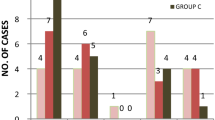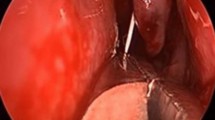Abstract
To propose a simple technique for preservation, medialization and stabilization of the middle turbinate through a planned medial synechiae formation using suction electrocautery between middle turbinate and nasal septum. Study design is Case series. 150 cases of chronic rhino sinusitis who underwent ESS were selected and stabilization of the middle turbinate through a planned medial synechiae formation using suction electrocautery was done as last step and results studied. Adequate medialization was achieved in 141 cases with 94% success rate. This technique of medialization of middle turbinate through a planned medial synechiae formation using cautery between middle turbinate and nasal septum is simple, quick to perform, do not require any special or costly instrument, do not require any special training and thus can be easily done by beginners also and most importantly with good success rate and surgery outcome.





Similar content being viewed by others
References
Hewitt Kim M, Orlandi Richard R (2008) Suture medialization of the middle turbinates during endoscopic sinus surgery. Ear Nose Throat J 87(12):E11
Bhalla RK, Kaushik V, de Carpentier J (2005) Conchopexy suture to prevent middle turbinate lateralization and septal haematoma after endoscopic sinus surgery. Rhinology 43:143–145
Smith LF, Brindley PC (1993) Indications, evaluation, complications, and results of functional endoscopic sinus surgery in 200 patients. Otolaryngol Head Neck Surg 108(6):688–696
Stankiewicz JA (1989) Complications of endoscopic sinus surgery. Otolaryngol Clin North Am 22(4):749–758
Bolger WE, Kuhn FA, Kennedy DW (1999) Middle turbinate stabilization after functional endoscopic sinus surgery: the controlled synechiae technique. Laryngoscope 109:1852–1853
Friedman M, Landsberg R, Tanyeri H (2000) Middle turbinate medialisation and preservation in endoscopic sinus surgery. Otolaryngol Head Neck Surg 123:76–80
Lindemann J, Keck T, Rettinger G (2002) Septal turbinate suture in endonasal sinus surgery. Rhinology 40:92–94
Moukarzel N, Nehme A, Mansour S, Yammine FG, Moukheiber A (2000) Middle turbinate medialisation technique in functional endoscopic sinus surgery. J Otoplaryngol 29:144–147
Biedlingmaier JF (1993) Endoscopic sinus surgery with middle turbinate resection: results and complications. Ear Nose Throat J 72(5):351–355
Lazar RH, Younis RT, Long TE, Gross CW (1992) Revision functional endonasal sinus surgery. Ear Nose Throat J 71(3):131–133
Lee JY, Lee SW (2007) Preventing lateral synechia formation after endoscopic sinus surgery with a silastic sheet. Arch Otolaryngol Head Neck Surg 133(8):776–779
Shikani AH (1994) A new middle meatal antrostomy stent for functional endoscopic sinus surgery. Laryngoscope 104:638–641
Thorton RT (1996) MT stabilization technique in endoscopic sinus surgery. Arch Otolaryngol Head Neck Surg 122:869–872
Abelardo E, Sanuki T, Yumoto E (2006) Medialization and stabilization of the middle turbinate using nasal septal flap in endoscopic sinus surgery. Philipp J Otolaryngol Head Neck Surg 21(1, 2):43–46
Funding
There are no financial interests the authors may have in companies or other entities that have an interest in the information in the contribution (e.g., grants, advisory boards, employment, consultancies, contracts, honoraria, royalties, expert testimony, partnerships, or stock ownership in medically related fields). The authors have no financial interest.
Author information
Authors and Affiliations
Corresponding author
Ethics declarations
Conflict of interest
The authors declare that they have no conflict of interest.
Ethical Approval
All procedures performed in studies involving human participants were in accordance with the ethical standards of the institutional and/or national research committee and with the 1964 Helsinki declaration and its later amendments or comparable ethical standards.
Informed Consent
Informed consent was obtained from all individual participants included in the study.
Rights and permissions
About this article
Cite this article
Bansal, C., Singh, V.P. Management of Unstable Middle Turbinate in Endoscopic Sinus Surgery. Indian J Otolaryngol Head Neck Surg 71 (Suppl 3), 1940–1943 (2019). https://doi.org/10.1007/s12070-018-1353-0
Received:
Accepted:
Published:
Issue Date:
DOI: https://doi.org/10.1007/s12070-018-1353-0




